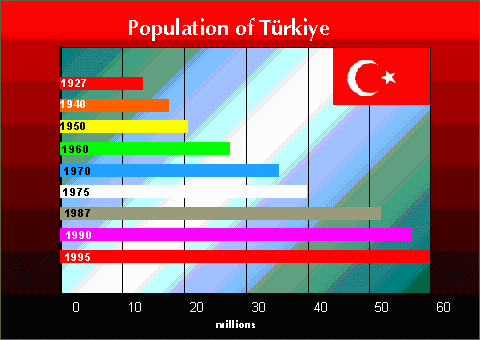|
|
|
TURKEY

GEOGRAPHY AND RESOURCES OF TURKEY
Total Area:
779,452 square km.
Thrace: 23,764 square km.
(Europe) Anatolia:755,688 square km.
(Asia).
Max. length; 1,565 km. Average width: 550km.
Coastlines:
8,372 km. Aegean:
2,805 km. Mediterranean: 1,577 km.
Black Sea: 1,695 km. Marmara: 927
km.
Frontiers:
2,753 km. Syria: 877
km.
Former USSR (Georgia, Armenia, Nakhitchevan); 610 km Iran: 545 km. Irak:
331 km.
Bulgaria 269 km. Greece: 212 km.
Land:
30% arable; 4% permanent
crops; 12% meadows and pastures;
26% forest and woodland; 28%
other.
Lakes:
9,423 square km. In order
of size: Van, Tuz Golu (Salt Lake), Beysehir,
Egridir, Aksehir, Iznik,
Burdur, Manyas, Acigol, Ulubat (Apolyont).
Mountains, Max. altitude:
Agrý: 5,165 m. Kackar; 3,923 m.
Erciyes; 3,917 m. B Hasan; 3,268 m.
Nemrut: 2,282 m.
Uludag : 2,543 m. Average altitude; 1,131 m
(80% of land above 500 m. altitude)
Rivers:
Firat (Euphrates): 1,263
km. (in Turkey) Kizilirmak: 1,182 km.
Sakarya: 824 km. Murat: 722 km. Seyhan:
560 km.
Menderes (Meander): 584 km. Dicle (Tigris): 523 km. (in
Turkey)
Yesilirmak 519 km. Ceyhan: 509 km.Porsuk: 488 km.
Coruh: 442 km.
Gediz: 401 km.
Islands:
Aegean Sea: Gokceada,
Bozcaada, Uzunada, Alibey
Marmara Avsa Isles:Eknik, Koyun, Pasalimani,
Princes' Isles: Buyukada, Heybeliada, Burgaz, Kinali,
Sedef,
Mediterranean: Karaada, Salih, Kekova
Straits:
Bosphorus (links Black
Sea to Marmara Sea),
Dardanelles (links Marmara Sea to Aegean
Sea).
Regions:
Seven geographical and
administrative regions:
Marmara, Aegean, Mediterranean, Black Sea, Central
Anatolian,
Eastern, Southeastern.
Climate:
Three climate
zones:
Mediterranean (hot and dry summers, mild and wet winters),
Continental
(hot and dry summers, cold and harsh winters).
Black Sea:
(temperate and wet all year long).
Hydroelectric
generators:
(capacity in thousands of megawatts) Ataturk Dam
on
Firat (8400), Karakaya Dam on Firat (7,354), Keban Dam on Firat
(5,800),
Oymapinar Dam on Manavgat (1,920), Gokcekaya Dam on Sakarya
(562), Sanyar Dam
on Sakarya (400), Hirfanli Dam on Kizilirmak (400).
Thermoelectric
generators:
Ambarli (4,500), Seyitomer (1,800), Tuncbilek (830),
Catalagzi (800), Mersin (700), Sihaltaraga (450).
Agricultural output:
Wheat (20
million tons),barley (7.3 million tons), corn (2.3 million tons),
cotton
(990,000 tons), tobacco (287,500 tons), hazelnuts (375,000 tons.
Natural resources:
Oil, coal,
iron ore, copper, uranium, manganese, antimony,
chromium, mercury, borate,
sulphur, zinc, borax, meerschaum.

GOVERNMENT AND LEGAL SYSTEM
Capital:
Ankara
Government type:
Parliamentary
democracy with free market economy
Proclamation of the Republic:
29
October 1923
Proclamation of the
Constitution:
7 November 1982
Administrative divisions:
79
provinces
Legislative:
Unicameral, Grand
National Assembly with 450 deputies
(general elections every 5
years)
Executive:
President (7-year
term) and Council of Ministers,
headed by Prime Minister (5-year
term)
Judiciary:
Independent, with
Constitutional Court supervising conformity
of laws to the 1982
Constitution. Turkish laws have been derived
from various European systems,
mainly French, Italian, Swiss.
Right to vote:
At the age of 18
Major international
organization:
UN, NATO, OECD, CSCE (Conf. on Sec. and Co. in Europe),
UN. European, Parliament, EC (associate member), GATT, Black Sea Economic
Cooperation, WHO, IMF, ILO, UNESCO, ECOSOC, FAO, IDB (Islamic Development Bank),
INTELSAT, INTERPOL.
Official
language:
Turkish
Religions:
Muslim 98%, Jewish,
and many Christian sects: 2%.
Currency:
Turkish lira
(Tl)